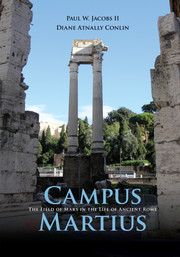Book contents
- Frontmatter
- Contents
- Illustrations
- Acknowledgments
- Maps
- Introduction: “This Place Was Holiest of All”
- Chapter One “The Size of the Plain Is Remarkable”: Defining the Limits of the Campus Martius in Time and Space
- Chapter Two Gathering Troops in the War God's Field
- Chapter Three “Very Costly Temples”: The Campus Martius and Republican Temple Construction
- Chapter Four “Chariot Races,” “Three Theatres,” “An Amphitheatre,” and More: Entertainment in the Campus Martius
- Chapter Five “Colonnades about It in Very Great Numbers”: The Porticoes of the Campus Martius
- Chapter Six Between the Aqua Virgo and the Tiber: Water and the Field of Mars
- Chapter Seven “A Zeal for Buildings”: Reshaping of the Space by the Emperors
- Conclusion: “The Rest of the City a Mere Accessory”
- Appendix A Chronology of Development in the Campus Martius to the Early Fourth Century c.e.
- Appendix B Glossary of Architectural Terms
- Notes
- Selected Bibliography
- Index
- Plate Section
Introduction: “This Place Was Holiest of All”
Published online by Cambridge University Press: 18 December 2014
- Frontmatter
- Contents
- Illustrations
- Acknowledgments
- Maps
- Introduction: “This Place Was Holiest of All”
- Chapter One “The Size of the Plain Is Remarkable”: Defining the Limits of the Campus Martius in Time and Space
- Chapter Two Gathering Troops in the War God's Field
- Chapter Three “Very Costly Temples”: The Campus Martius and Republican Temple Construction
- Chapter Four “Chariot Races,” “Three Theatres,” “An Amphitheatre,” and More: Entertainment in the Campus Martius
- Chapter Five “Colonnades about It in Very Great Numbers”: The Porticoes of the Campus Martius
- Chapter Six Between the Aqua Virgo and the Tiber: Water and the Field of Mars
- Chapter Seven “A Zeal for Buildings”: Reshaping of the Space by the Emperors
- Conclusion: “The Rest of the City a Mere Accessory”
- Appendix A Chronology of Development in the Campus Martius to the Early Fourth Century c.e.
- Appendix B Glossary of Architectural Terms
- Notes
- Selected Bibliography
- Index
- Plate Section
Summary
During or just after the reign of Rome's first emperor Augustus (r. 27 b.c.e.–14 c.e.), the Greek geographer Strabo penned his work Geographica and provided a valuable description of many of the peoples and places in the Greco-Roman world. When Strabo reported the “best accredited story of the founding of Rome,” he recounted the tale, “partly fabulous but partly closer to the truth,” of Rhea Silvia, a woman forced by her uncle Amulius to become a Vestal Virgin to assure she would remain childless, thereby preventing the birth of a potential political rival. Notwithstanding her sacred inviolability, Rhea Silvia was impregnated by the god Mars. She gave birth to Romulus and Remus, semidivine twin boys who grew into manhood, defeated Amulius and his sons, and established the foundations for the city of Rome.
Lacking natural defenses and usable arable land, the location for Rome's foundation was suitable “more as a matter of necessity than of choice.” For his part, Strabo forgave the early Romans for not beautifying their city, citing their understandable preoccupation with matters of government and war. The successors to Rome's mythical founders would eventually reduce its vulnerability by building protective circuit walls and defensive gates as early as the fourth century b.c.e. By the reign of Augustus, however, Strabo noted that circumstances had indeed changed. Rome's leaders of the late republic and the first imperial court had not neglected the city's infrastructure; rather they filled Rome with “many beautiful structures.”
In fact, Pompey, the Deified Caesar, Augustus, his sons and friends, and wife and sister, have outdone all others in their zeal for buildings and in the expense incurred. The Campus Martius contains most of these, and thus, in addition to its natural beauty, it has received still further adornment as a result of foresight.
- Type
- Chapter
- Information
- Campus MartiusThe Field of Mars in the Life of Ancient Rome, pp. 1 - 6Publisher: Cambridge University PressPrint publication year: 2015



